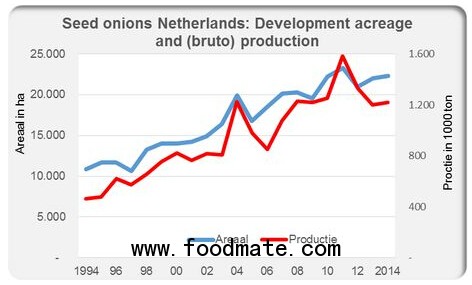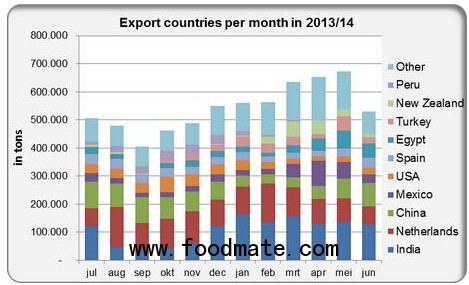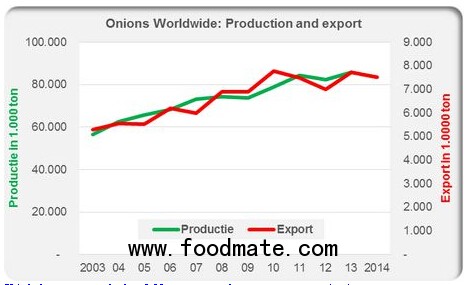However, since 2010, global trade declined to a near-standstill, fluctuating around 7.5 million tons. Nevertheless, determining the current size of global onion trade is quite difficult. Sometimes there are vast differences between the statistics of different countries. Exports from country A to country B is not always equivalent to the import of country B from country A.

India and China: lots of onions!
Onions represent a truly global product. There are few countries where onions aren’t grown or consumed. Not all countries succeed in growing onions year-round, let alone produce them in acceptable quality. And with the world’s population ever rising, demand continues to grow. On a global scale, this increased demand is mostly covered by local production as opposed to import.
China and India are not only by far the most populous countries, but also real onion superpowers. Today, these two countries represent nearly half of the world’s production. Ten years ago, the share of these two countries was some 40 percent. China is the largest with a (commercial) production of over 22 million tons. India produces nearly 20 million tons. The rest of Asia accounts for another 15 million tons. The continents of Africa, America and Europe are good for almost 10 million tons of onions.
The two superpowers also export a lot of onions, India more than China. India is the world's second largest exporter (after the Netherlands) with an export of 1.2 million tons in 2014. China is the world's third largest exporter, with exports of 0.7 million tons. Apart from India and China, the Asian continent is by far the largest with regard to imports. Key countries are Malaysia, Bangladesh, Japan and the Gulf states.

Year-round produce; also worldwide
All major exporting countries are able to supply markets year-round. The export of India is largest in the first half of the year. Netherlands is almost always fully represented, with only a dip in the summer months. The export of China is largest in the second half of the year.
Globally, the export of all nations is the largest in the period March-May and the smallest in the period July-November.
Netherlands remains largest exporter
In 2014, the Netherlands were again the world’s foremost exporter of onions. According to figures from the KCB, over 960,000 tons of Dutch onions were sold abroad in 2014: the same as in 2013 and more than the immediately preceding years. Eurostat gives an export figure of 1.05 million tons, including re-exports. CBS comes to an even higher figure, viz. 1.38 million tons of onions excluding spring onions and shallots.
Both Eurostat and CBS record imports and exports of seed onions, spring onions and shallots separately. Most other countries only register a total figure of these three, but that's not such a big problem as there are very few countries with significant trade in spring onion and shallots.
Last year, the Netherlands exported 150,000 tons of spring onions and 26,000 tons of shallots. The total export value of all three species amounted to 470 million euros.
Netherlands imports from many countries outside the EU
Netherlands also imports significant quantities of onions. About 190,000 tons last year, with a value of 80 million euros according to CBS. Eurostat, conversely, recorded an import of 130,000 tons in 2014. The majority comes from outside the EU with New Zealand and Egypt as key suppliers. Other countries include Belgium, France, Poland, Germany, Australia and Spain.
Stagnating Dutch production?
Generally speaking, there is still growth in the Dutch onion acreage. The 22,350 ha in 2014, however, was not the largest in history. In 2011, it was more. The production shows fluctuations. The 1.22 million tons in 2014 was surpassed by other years and especially by the 1.5 million-ton harvest in 2011.

Netherlands ships to faraway destinations, other countries stay closer to home
The Netherlands tends to ship outside the region. Many Dutch onions are sold in Africa. Senegal has been the main buyer for years, with Guinea, Ivory Coast, Mauritania, Mali, Sierra Leone, Gambia and Congo also taking in considerable volumes. Large quantities of Dutch onions go to Asian countries like Malaysia and Indonesia. Also go significant quantities. Major importing countries in Latin America are Brazil, Panama and Jamaica. Within Europe, the UK is a major customer. Before the boycott went into effect last year, a lot of onions were sold to Russia.
India exports to many countries in own region
India and other large exporter also sell onions to countries in the region. Bangladesh, Malaysia, Sri Lanka, Indonesia and Nepal are important customers, as are the Gulf states. China exports a lot to Japan, Vietnam, Malaysia and Thailand, but Russia is also a major recipient of Chinese onions.
The numbers four and five on the export list are Mexico and the United States. Mexican onions almost exclusively go to the USA. US exports tend to go to Canada and Mexico, and to Taiwan and Japan.
Many Egyptian onions to Gulf States but also to EU
Egypt is the world's sixth largest exporter. Most Egyptian onions go to the Gulf States, but Russia is also a major customer. Quite a few Egyptian onions go the Netherlands, the UK and Germany.
7th largest exporter is Spain. The export of Spain is very much focused on EU countries. But last year, Brazil was also an important customer.
Then come two South American countries, Argentina and Peru. Exports from Argentina show fluctuations, pointing to a negative trend. Peruvian export, though, is growing. Argentine export relies heavily on marketing in Brazil, while Peru increasingly relies on the United States. Columbia is another important customer.
US and UK largest importers
The largest onion import countries are the United States and the United Kingdom. The United States imported half a million tons last year, a record. Mexico is the main supplier, though there are also reasonable quantities coming from Canada, Peru and Chile. For the UK, Spain is the main supplier, followed by the Netherlands.
Other importers are Malaysia, Bangladesh, Japan, the Gulf States.
For many African countries receiving Dutch onions, the Netherlands is usually the only foreign supplier. Senegal also imports from Belgium, Bulgaria, Turkey and Albania. Ivory Coast gets foreign onions from Niger and Burkina Faso, in addition to Dutch produce.





